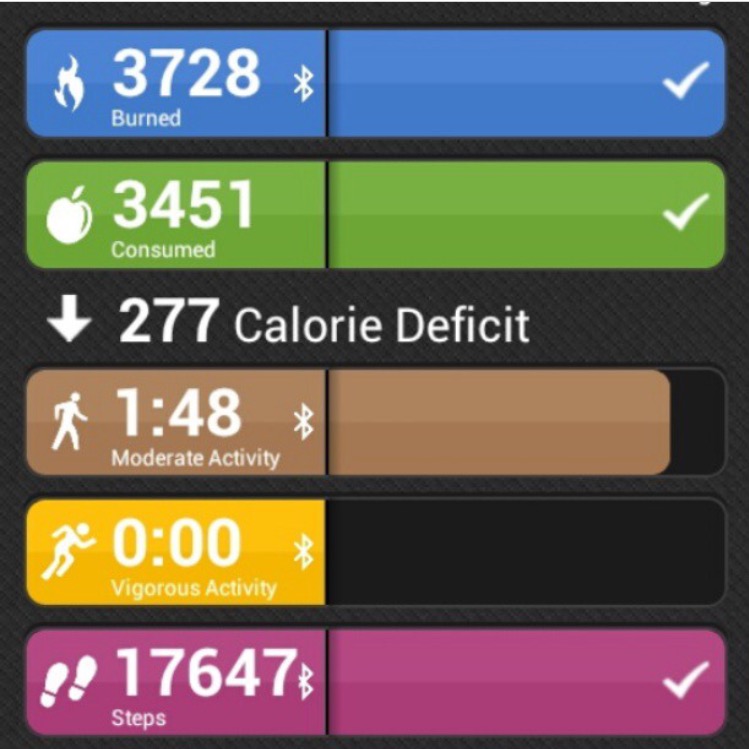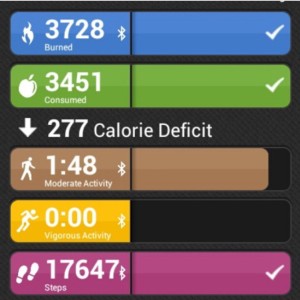 So… You’ve been doing some reading and have come to the conclusion that you have been under-eating, over exercising, and your metabolism is now suffering. You may have also decided that you need to do a metabolic reset in order to get your metabolism back up and running where it should be. Now what?
So… You’ve been doing some reading and have come to the conclusion that you have been under-eating, over exercising, and your metabolism is now suffering. You may have also decided that you need to do a metabolic reset in order to get your metabolism back up and running where it should be. Now what?
The first thing that you need to in order to start this process is to determine your TDEE (Total Daily Energy Expenditure). Your TDEE is the amount of calories that your body requires to maintain your weight. That (TDEE) figure includes your BMR (Basal Metabolic Rate) as well as your normal day-to-day activities plus any formal exercise. In theory — based on this definition — if we eat at our TDEE, we will maintain our weight. The problem is that this theory does not always hold true. When we have been under-eating and over-exercising, our body will adapt to this stress. In an attempt to maintain homeostasis, it will down-regulate the metabolism to match the decreased intake. The result will often be a suppressed metabolism. This explains why suddenly you may find yourself gaining weight while doing hours of cardio and eating 1,200 calories or less a day … your body has adapted! You have decreased your intake and increased your exercise for a long enough period of time that the body has finally slowed down your metabolism to match the intake. Your body is doing what it is supposed to do = maintain homeostasis.
To get your metabolism back up and running where it should be, you’ll need to increase your caloric intake back up to TDEE, or do a Metabolic Reset. To begin this process, the first thing you will want to do is go to an online calculator and enter your stats to get your TDEE (maintenance) calories. This will give you an idea of what your ultimate goal will be. But remember that these calculators just give you estimates. They are subject to error based on how much exercise you input into the calculator and how active you truly are. Many newbies to EM2WL lead very active lives, and may actually burn a lot more through their day-to-day activities. If they simply enter in the 4 hours of formal exercise that they do each week, their final TDEE estimate may actually be too low.
Alternatively, you can use an on-body device such as a FitBit, or BodyMedia band to get an idea of how much you burn each day. These are likely more accurate than the calculators, just because they’re monitoring how much activity you actually do each and every day. However, these devices are also not 100% accurate because they don’t accurately calculate calories burned from your strength training workouts.
So, where does this leave you? How do you figure out your “true” TDEE? You have your TDEE estimate and/or your “on-body device” average, but ideally you will also test out these numbers and make sure they are truly accurate for you.
The normal process for doing a Metabolic Reset involves increasing your caloric intake up to your calculated TDEE and staying at that level for a minimum of 8 – 12 weeks (much longer if you come from a history of severe dieting or caloric restriction). We generally recommend that you make this increase slowly, adding approximately 50-100 calories to your daily intake each week. Of course, you can certainly jump right up to TDEE quickly (“rip the band-aid”) or make those increases more substantial, but you may find the increases on the scale to be discouraging. By making the increases more gradually, you can often avoid some of the gains seen during the “rip the bandaid” approach. We leave this to the individual as a personal decision.
Now, back to the original question … “How Do I Find My True TDEE?” In order to do this, you will most likely need to go through a trial and error process. You have your calculated TDEE, but how do you figure out if that is “true” or not? As you are going through the process, gradually increasing your daily caloric intake 100 calories a week, keep an eye on the scale. Generally, as you make these increases, you may see the scale jump up a pound or two, and then during the course of the week, it will generally trend back downwards, often ending up right back where you started, pre-increase. As you get closer and closer to your calculated TDEE, you may find that it takes a bit longer for your weight to stabilize and drop back down. At this point, if you find that happening, you may want to take it a bit slower. Then if your weight has not stabilized and dropped back down by the end of the week, wait until it does before making any further increases.
Once you are at or near your calculated TDEE, watch for slow and steady increases on the scale which do not stabilize over time. If you do start seeing gains like this, you have most likely surpassed your TDEE, and which point you can back down on your intake by 100 calories or so and you should be right there — at your true TDEE.
What many people find is that their actual TDEE may be higher than what they get with the calculators. Often their day-to-day activities (chasing kids, doing laundry…etc.) makes them more active than the activity level that they chose when inputting their data into a calculator. We often tend to underestimate how active we are. Many people find that they are actually able to eat 100 or 200 calories more than the calculators give them, simply by “testing the waters” and not blindly accepting those numbers as accurate.
So, give it a try! Surely by now, you have resigned yourself to the fact that this is not a fast process, so take the time to make sure you know your “true TDEE.” Don’t blindly trust the calculators, test it out and see how much you can really eat before you start seeing true gains. Ignore those monthly fluctuations and the jumps that occur after increasing your intake. Keep pushing your intake higher and higher until you start to see slow, steady gains that do not stabilize over time. As hard as it may be, don’t worry about gaining. You can always just drop your intake down and those gains will stop. Remember: nothing that you are doing during this process is irreversible. Take the time to do it right … right from the beginning. You won’t regret it!
Just starting the process and need a step-by-step guide? Get our FREE Quick Start Guide!
Are you curious about how the process works, or wondering what's in our Starter Kit E-Book? START HERE. We'll send you a free breakdown of the basics, exclusive videos explaining why everything that you've learned about diets have only led you astray, and an action plan to take your life back immediately.
No worries, we hate spam too!






The bodymedia devices are not the sexiest things out there, but they are by far the most accurate still. We’ll see what 2015 brings, of course, but it has been my experience that if you must know with near-100% accuracy what you are burning, go with Bodymedia. This will save you a ton of time in the short run. I am not an affiliate… just been around the block.
I totally agree. In terms of accuracy, I found the BodyMedia to be much more reliable (at least for me). I find that the FitBit will count a lot of my hand motions (even when worn on my non-dominant hand). But you are right, the BodyMedia bands are definitely not the sexiest things around… I found that I wore mine consistently during the winter, but then finally gave it up in the summer — couldn’t handle the tan lines! :-D
I’ve had the chance to meet the-guy-who-knows-a-guy at Bodymedia, and they want to make them smaller too. Since they came out with their first prototypes (huge!) they have gotten smaller with each iteration, but this last design is about five years old. I’m guessing they are due for some smaller components soon. About the tan-lines… I hear ya. Many people I knew wore theirs on their thigh or calf, citing rogue research that it was just as effective, but the people from the company say it’s not designed to work that way. I really wonder what the Apple watch will do to their market. Thanks for the reply.